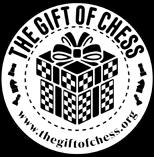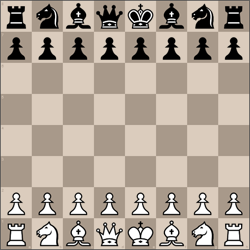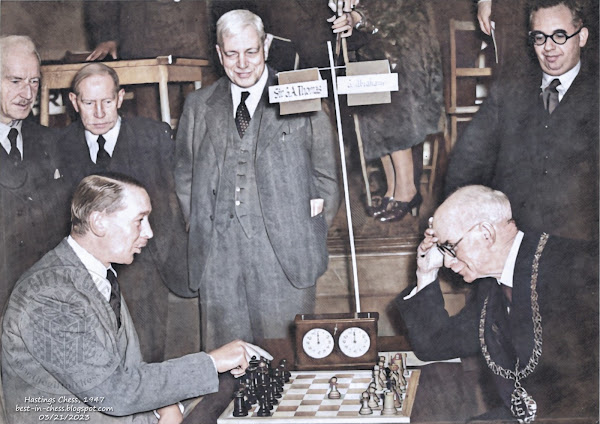March 26 1951
The Charlotte Observer, Charlotte, North Carolina, Monday, March 26, 1951
DR. PIERRE MACY, president of the Charlotte Chess Club, is shown here looking over the prizes which will be awarded during the North Carolina Chess association open championship tournament to be held in the Hotel Selwyn April 7 and 8.—(Observer Staff photo—Dumbell.)
The Charlotte Observer, Charlotte, North Carolina, Monday, March 26, 1951
CHAMPIONSHIP TOURNEY SET FOR APRIL
North Carolina Chess Aces Will Converge On Charlotte
BY WINK LOCKLAIR
Observer Staff Writer
Chess, apparently one of the few games in the world which has not so far been the subject of a probe or a scandal will attract a large number of visitors to the city during the first week end in April when the open championship tournament of the North Carolina Chess association gets under way in the Hotel Selwyn.
Host for the two-day event will be the Charlotte Chess club, a fairly new organization whose members gather every Tuesday evening at 7:30 in room 111 of the Y.M.C.A. The clubs roster is made up of businessmen, lawyers, and salesmen as well as some of the younger crowd, all in all a pretty staid, gentle group of men.
The game itself is considered the most cosmopolitan of all games having been invented in the East, introduced into the West, and now played all over the world. “It has often been said that life is just a game of chess and those who have made a study of the game and its history can well agree: it represents the battle of life of here and hereafter.” says George Goodwin one of the game's local enthusiasts, treasurer, and acting secretary of the Charlotte Chess club.
NOAH'S ARK TRAP
“There is an ancient story that goes back to the days of the great flood when Noah built his ark. The story goes that, to while away the dreary hours on the ark and to steel themselves against the raging waters, Noah and his sons got into the habit of playing chess. One of the games which was recorded and used as a warning for the future has since become known as the Noah's Ark Trap. This is a warning that could be well used today.
“As many folks know the Russians are the world champion chess players, Uncle Joe Stalin and his men are trying every way they know to lead the United States into the Noah's Ark Trap. If they could have their way we would all be slaves and subjects of Russian dictatorship. But we are now awake and if the Russians don't watch out they'll walk into another kind of trap more severe than Noah's Ark.” warns Mr. Goodwin.
The trap Mr. Goodwin was referring to is known as the Legal's Trap in which greed overcomes judgment and a complete checkmate comes about with strokes from the bishop and the knight.
Because of its relation to the movements of armies chess has been highly regarded by military men since the reign of Emperor Charlemagne and even rulers before him. A complete set, including pawns, can represent the Crusaders and the Saracens, with the white pieces symbolic of the Christians and the black ones symbolizing the Turks. Tables for the local tournament will be set up with various kinds of sets some very valuable with hand carved pieces, others carved from rare wood representative of ancient wars when knights in armor went out with their armies to fight for the protection of their king and country.
Strategy in chess has been handed down for generations. There are many planes of attack and maneuver both as to openings middle game and end play. In some of the tournaments many hours are necessary for the completion of one move. However the local contest will require 50 moves in two hours.
“Chess players resemble two generals fighting it out. It is a form of battle for life between those who would dominate and those who refuse to submit,” Mr. Goodwin points out.
YOUNGSTER TO PLAY
If this is the case, one of the generals is going to be considerably younger than most commanders. He is 15-year-o1d Kit Crittenden, a high school student from Raleigh, who, in 1948, became the nation's youngest state chess champion. He has been a member of the Raleigh club for some time and is expected to give most of the old-timers stiff competition.
The local tournament was arranged by Henry A. Gaede, vice president of the club and Ephraim Solkoff, president of the North Carolina Chess association. Entries have been coming in from Raleigh, Durham, Wilmington, High Point, Greensboro and Winston-Salem, as well as from Charleston, Greenville, Spartanburg, and Rock Hill in South Carolina. Entries from Michigan and Maryland have also been received. All in all it will be an interesting two days of battle for the prizes which include a handsome chess set, a set of clocks, and a copy of the book “Royal Masters in Battle Royal”.


































